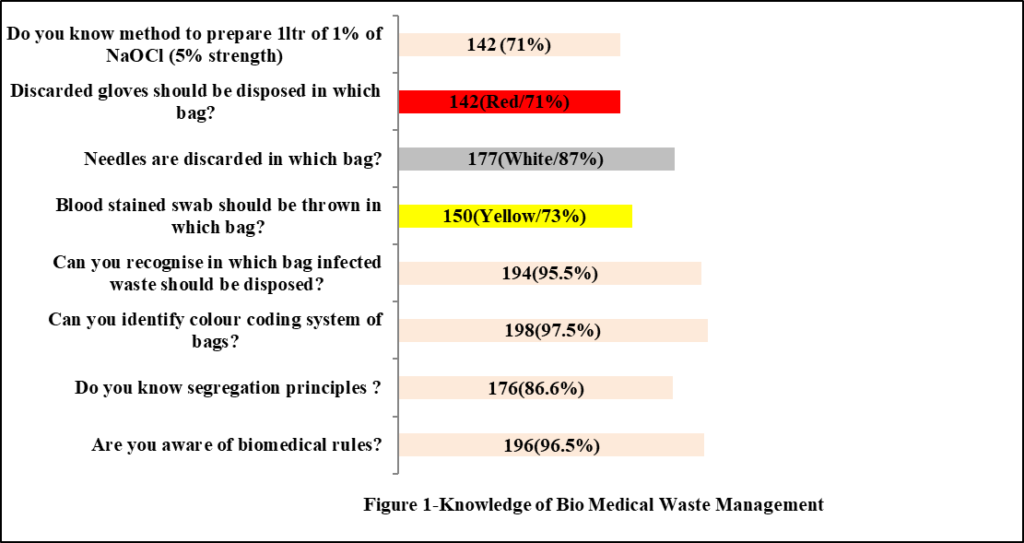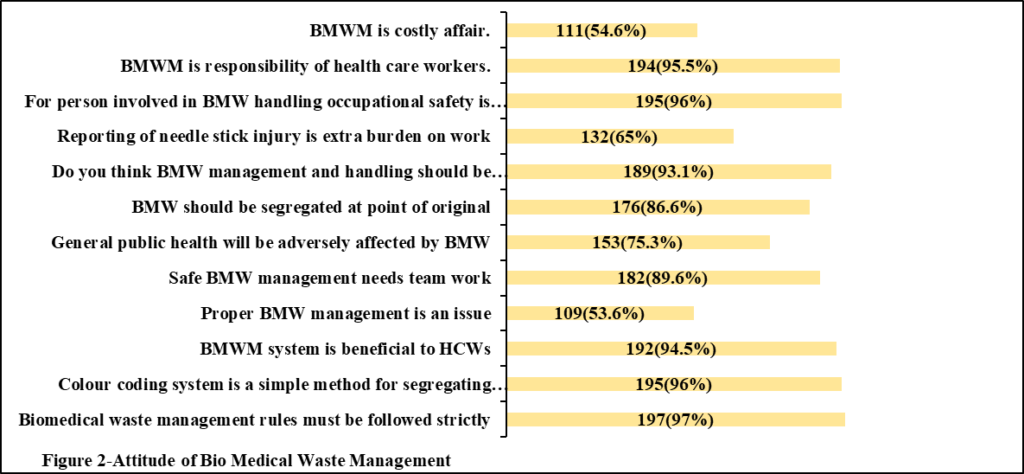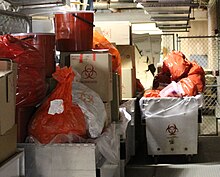Research Article
Dr. Nilanjan Dam1, Dr. Poonam Kushwaha2, Dr. Saket Shekhar3, Dr. S.P. Singh4, Dr. Anju Gahlot5
1. MD Fellow, Department of Community Medicine, RMCHRC, Kanpur, U.P., India; 2 Assistant Prof, Department of Community Medicine, RMCHRC, Kanpur, U.P., India; 4Associate Prof, Department of Community Medicine, RMCHRC, Kanpur, U.P., India; 5 Professor and HOD, Department of Community Medicine, RMCHRC, Kanpur, U.P, India.
Submitted: 20 June 2024; Accepted: 28 June 2024; Published: 29 July 5 2024
Corresponding Author: Dr. Nilanjan Dam, MD Fellow, Department of Community Medicine, RMCHRC, Kanpur, U.P., India. Email: [email protected]
INTRODUCTION
Biomedical waste management is critical to India’s public health and environmental protection. With the rapid growth of the healthcare sector, biomedical waste generation has increased significantly, posing challenges in its proper handling, treatment, and disposal. This comprehensive analysis provides an overview of the current status of biomedical waste management in India, including the regulatory framework, categorization of waste, segregation practices, collection and transportation methods, treatment and disposal technologies, record-keeping requirements, training and awareness programs, monitoring and enforcement mechanisms, and emerging trends. The analysis also explores the challenges healthcare facilities, regulatory authorities, and other stakeholders face in ensuring effective biomedical waste management and proposes strategies to address these challenges. Furthermore, it discusses innovative approaches and future directions to promote sustainable biomedical waste management practices and safeguard public health and the environment.
Efforts to combat the Coronavirus disease (COVID-19) pandemic have significantly increased the quantity of bio-medical waste (BMW) generation. Emphasis should be given to awareness and training all HCWs regarding proper BMW management during this pandemic to prevent infection transmission.[1]
Bio-medical waste (BMW) management is of utmost importance as its improper management seriously threatens healthcare workers, waste handlers, patients, caregivers, the community, and the environment. Simultaneously, the health care providers should know the quantity of waste generated in their facility and try to reduce the waste generation in day-to-day work because a lesser BMW amount means a lesser burden on waste disposal work and cost savings.[2]
Evolution of Biomedical Waste Management Rules in India
The management of biomedical waste in India has evolved over the years in response to growing concerns about its impact on public health and the environment. The journey of regulatory development in this area can be summarized as follows:
- 1998: First Biomedical Waste Management Rules: The Government of India introduced the Biomedical Waste (Management and Handling) Rules in 1998 to regulate biomedical waste management. These rules aimed to ensure the safe handling, segregation, storage, transportation, treatment, and disposal of biomedical waste generated by healthcare facilities.
- Amendments and Enhancements: Over the years, the Biomedical Waste Management Rules underwent several amendments to strengthen regulatory provisions, enhance compliance, and address emerging challenges. These amendments incorporated feedback from stakeholders, advancements in technology, and best practices in waste management.
- 2016: Revised Biomedical Waste Management Rules: The most significant revision to the Biomedical Waste Management Rules was made in 2016, which replaced the earlier rules of 1998. The revised rules introduced several key changes, including expanded scope, stricter compliance requirements, and updated standards for waste management practices.[3]
Waste management has become critical, posing potential health risks and environmental damage. It has taken a central place in the national health policy and is attracting considerable international interest. India participated in the United Nations Conference on the Human Environment held in Stockholm in June 1972, where decisions were taken to take appropriate steps to protect and improve the human environment.[4]
The safe & sustainable management of BMWs is a legal and social responsibility of everyone involved in providing or utilizing healthcare services (i.e., patients, families, HCWs, hospital administration, and health system). The BMW Rules, 2016 (further amended in 2018 & 2019) is a joint product of research made by agencies such as the Centre for Chronic Disease Control, Health Care Without Harm, and the Centre for Environmental Health under the Public Health Foundation of India. This guideline was introduced to create a stringent and elaborate set of rules and change how BMWs are managed in India. Monitoring the activities in health facilities and their compliance with the standard guidelines is important, as proper compliance with BMW practices ensures the safety of patients and HCWs.[5]
Healthcare waste (HCW) includes all the waste medical facilities generate. It comprises waste produced during testing, treatment, or vaccination of humans or animals. The quantity of general (non-hazardous) waste is 70–80% of total waste generated by health care facilities (HCFs).[6]
Pathology, microbiology, blood bank, and other diagnostic laboratories generate a sizable amount of biomedical waste (BMW). BMW’s audit is required to plan proper strategies. The audit in our laboratory revealed 8 kgs of anatomical waste, 600 kgs of microbiology waste, 220 kgs waste sharps, 15 kgs of soiled waste, 111 kgs of solid waste, 480 liters of liquid waste along with 33,000 liters per month of liquid waste generated from labware washing and laboratory cleaning and 162 liters of chemical waste per month.[7]
Devoted healthcare workers and facilities are also significant. Further, the proper and continuous monitoring of BMW is a vital necessity. Therefore, developing environmentally friendly methods and the right plan and protocols for the disposal of BMW is very important to achieve the goal of a green and clean environment. This review article aims to provide systematic, evidence-based information and an organized, comprehensive study of BMW[8].
BACKGROUND
In healthcare facilities, a significant amount of infectious material and biomedical waste (BMW) is produced during patient care, and healthcare professionals regularly handle these materials. Therefore, healthcare professionals must have the necessary knowledge, attitude, and practice regarding managing BMW.
AIMS AND OBJECTIVES
This study is, therefore, conducted to assess the knowledge, attitude, and practices of BMW management among healthcare workers in our institution.
MATERIAL AND METHOD
The Institution, cross-sectional study will be conducted among all health care workers (paramedical staff, nursing staff, lab technicians, attendants, GNM and other trainees) of either sex, any age, involved in various procedures done during diagnostic, therapeutic, and vaccination etc. outpatient departments (OPD), indoor patient departments (IPD) and emergency/ causality of Rama Medical College Hospital and Research Centre, Mandhana, Kanpur, those who will give consent, with total enumerative sampling from August 2023 onwards.
Subjects will be recruited after informed consent. Data collection and entry will be done using Google Forms. Collected data will be tabulated, analyzed, and interpreted by Jamovi 2.2.5.0. Continuous data will be presented as frequency, percentage, and Mean and SD. Categorical variables will be presented as frequency & percentages. Appropriate statistical tests will be applied accordingly. 95% confidence intervals (CI) and p-value (<0.05) will be considered significant. Confidentiality of the given information will be maintained.
Ethical approval will be obtained from the Institutional Ethical and Research Advisory Committee, Rama Medical College Hospital and Research Centre, Mandhana, Kanpur.
RESULTS
Profile of study subjects-
In the study, females 159 (78.3%) outnumbered males 44 (21.7%). The mean age of the subjects was 22.7 (±4.12), ranging from 17 to 53 years. 82 (40.4%) nursing staff,83 (40.9%)nursing students, and 20 (9.9%) paramedical staff participated in the study. 167 (82.3%) subjects received training regarding BMW. 159 (78.3%)subjects were vaccinated against Hepatitis B.
Table 1 Profile of Study Subjects
| Variable | Sub Groups | Mean (±SD) / Frequency (n); % |
| Age | 22.7 (±4.12) | |
| Sex | Male | 44 (21.7%) |
| Female | 159(78.3%) | |
| Occupation | Nursing Staff | 82 (40.4%) |
| Nursing Students | 83 (40.9%) | |
| Paramedical Staff | 20 (9.9%) | |
| Level Of Education | Graduate or higher education | 117 (57.3%) |
| Intermediate | 73(35.9%) | |
| Middle school | 4(1.9%) | |
| Primary education | 9(4.4%) | |
| Experience (Years) | <1 | 97 (47.7%) |
| 2 – 5 | 86 (42.4%) | |
| 6 – 10 | 11 (5.4%) | |
| < 10 | 09 (4.4%) | |
| Hepatitis B vaccination status | 159 (78.3%) | |
| Training regarding BMWM received | 167 (82.2%) |
Knowledge of biomedical waste management among study subjects-
176 (86.7%) knew about segregation principles. 194 (95.6%) could recognize the right color bag for infected waste. 85 (41.9%) knew discarded drugs would be thrown in the right bag color. 177 (87.2%) segregate BMW at the point of origin.189 (93.1%) wear gloves while handling BMW.197 (97%) feel that BMW rules must be followed strictly.
Knowledge (Figure 1)

Attitude toward biomedical waste management among study subjects (Figure 2)

54.6% think BMW is a costly affair. 95.5% say BMW is the responsibility of healthcare workers. 86.6% say BMW should be segregated at the point of origin. 89.6% think Safe BMW management needs teamwork. 53.6% think Proper BMW management is an issue, 94.5% say the BMW system benefits HCWs (Healthcare Workers), and 96% say the Colour coding system is a simple method. 97% say that biomedical waste management rules must be followed. Overall, most respondents seem to agree with statements emphasizing the importance of proper BMW management, the responsibility of healthcare workers in BMW handling, and the necessity of adhering to biomedical waste management rules. However, there are also some statements where agreement is lower, indicating potential areas for improvement or differing opinions within the surveyed group.
Practice of biomedical waste management(Figure 3)

86.2% of respondents follow PEP after needle stick injury or percutaneous injury. 71.9% follow the use of a hub cutter to break needles. 83.7% follow chemical disinfection of discarded mattresses with body fluid. 82.2% follow chemical disinfection of discarded linen contaminated with blood. 93.1% wear gloves while handling BMW. 67.9% wear PPE (Personal Protective Equipment) while handling BMW. 87.1% segregate BMW at the point of origin. Most respondents seem to follow recommended practices for BMW management, such as wearing gloves, following post-exposure prophylaxis (PEP) after needle stick injuries, and segregating BMW at the point of origin. However, there are some practices, like using PPE while handling BMW, where the adherence is comparatively lower, indicating potential areas for improvement in safety protocols.
CONCLUSION
BMWM should be a shared teamwork with committed government backing, good BMW practices followed by health‑care workers and HCFs, continuous monitoring of BMW practices, and strong legislature [9]. Awareness and training programs should target doctors, nurses, paramedics, and waste handlers. Training of waste handlers should be practical and demonstrative [10]. Management of bio-medical waste is becoming a challenging issue in India. Governmental and nongovernmental agencies have recognized biomedical waste management as a concern [11]. Biomedical waste has a higher potential for infection and injury to healthcare workers, patients, and the surrounding community [12]. Despite India’s strict rules and regulations for the safe disposal of BMW, there is an instant need to take action to uplift the current system capacity and increase the funding and commitment toward the safe disposal of BMW [13]. BMWM should ideally be the subject of a national strategy with dedicated infrastructure, cradle-to-grave legislation, competent regulatory authority, and trained personnel. Improving the management of biomedical waste begins with waste minimization [14]. Logistic regression helped to identify the major factors that affect the performance of the healthcare facility, and it shows that regular training on BMW and improved infrastructure can improve BMW management practices [15].
REFERENCES
- Dalui A, Banerjee S, Roy R. Assessment of knowledge, attitude, and practice about biomedical waste management among healthcare workers during COVID-19 pandemic in a health district of West Bengal – PubMed. [cited 2023 Aug 25];
- Pandey A, Ahuja S, Madan M, Asthana AK. Bio-Medical Waste Management in a Tertiary Care Hospital: An Overview. J Clin Diagn Res JCDR. 2016 Nov;10(11):DC01–3.
- Bio-medical_Waste_Management_Rules_2016.pdf [Internet]. [cited 2023 Aug 25]. Available from:https://dhr.gov.in/sites/default/files/Biomedical_Waste_Management_Rules_2016.pdf
- Patil GV, Pokhrel K. Biomedical solid waste management in an Indian hospital: a case study. Waste Manag. 2005 Jan 1;25(6):592–9.
- Krishnamoorthy Y, R A, Rajaa S, Samuel G, Sinha I. Biomedical waste disposal practices among healthcare workers during COVID-19 pandemic in secondary and tertiary care facilities of Tamil Nadu. Indian J Med Microbiol. 2022;40(4):496–500.
- Dehal A, Vaidya AN, Kumar AR. Biomedical waste generation and management during COVID-19 pandemic in India: challenges and possible management strategies. Environ Sci Pollut Res Int. 2022;29(10):14830–45.
- Chitnis V, Vaidya K, Chitnis DS. Biomedical waste in laboratory medicine: audit and management – PubMed. [cited 2023 Aug 25]; Available from: https://pubmed.ncbi.nlm.nih.gov/15928414/
- Bansod HS, Deshmukh P. Biomedical Waste Management and Its Importance: A Systematic Review. Cureus. 15(2):e34589.
- Datta P, Mohi G, Chander J. Biomedical waste management in India: Critical appraisal. J Lab Physicians. 2018 Jan;10(01):006–14.
- Verma LK, Mani S, Sinha N, Rana S. Biomedical waste management in nursing homes and smaller hospitals in Delhi – PubMed. [cited 2023 Aug 25]; Available from: https://pubmed.ncbi.nlm.nih.gov/18358710/
- Tiwari A, Kadu P. Biomedical Waste Management Practices in India-A Review. 2014 Jan 1;
- Joseph L, Paul H, Premkumar J, Rabindranath, Paul R, Micael JS. Biomedical waste management: a study on the awareness and practice among healthcare workers in a tertiary teaching hospital – PubMed. [cited 2023 Aug 25]; Available from: https://pubmed.ncbi.nlm.nih.gov/25560016/
- Manekar SS, Bakal RL, Jawarkar RD, Charde MS. Challenges and measures while managing mounting biomedical waste in COVID-19 pandemic: an Indian approach. Bull Natl Res Cent. 2022;46(1):159.
- Capoor MR, Bhowmik KT. Current perspectives on biomedical waste management: Rules, conventions, and treatment technologies. Indian J Med Microbiol. 2017;35(2):157–64.
- Devi A, Ravindra K, Kaur M, Kumar R. Evaluation of biomedical waste management practices in India’s public and private health care facilities. Environ Sci Pollut Res. 2019 Sep 1;26(25):26082–9.
- Acknowledgment: We would like to express our deepest gratitude to our project supervisor, Dr. Anju Gahlot, for their invaluable guidance and support throughout the research process. Their expertise and dedication were instrumental in shaping this project. Their advice and valuable feedback enriched our work and made this project a joyful and pleasant experience. We want to thank Dr Anju Gahlot, HOD of Community Medicine, for allowing us to collaborate. We sincerely thank Dr B. K. Prasad, Principal of Rama Medical College, Hospital & Research Centre, Kanpur, for providing us with the environment and encouragement to conduct our research. Additionally, we would like to thank our seniors for their constructive feedback. We would also like to thank all the respondents who willingly participated in contributing valuable data to our project. Lastly, we congratulate ourselves on collaborating, enduring, and enjoying this project. It was a fun learning experience, and we played a significant role in shaping the outcome.
Not applicable
- Funding
Not applicable
- Informed Consent
Not applicable
- Conflict of Interest Statement
All the authors declared “No Conflict of Interest” with this publication.
- Additional Information
Not applicable
This open-access article is distributed under the terms of the Creative Commons Attribution License CC-BY 4.0., which permits unrestricted use, distribution, and reproduction in any medium, provided the original author and source are credited.
- DOI: 10.62996/daj.07072024
- Cite this Article Nilanjan Dam1, Poonam Kushwaha2, Saket Shekhar3, S.P. Singh4, Dr. Anju Gahlot5.Knowledge, attitude, and practices regarding biomedical waste management(BMWM) among healthcare workers in Tertiary care facilities. Diabetes Asia Journal. 2024;1(1): 48-55


